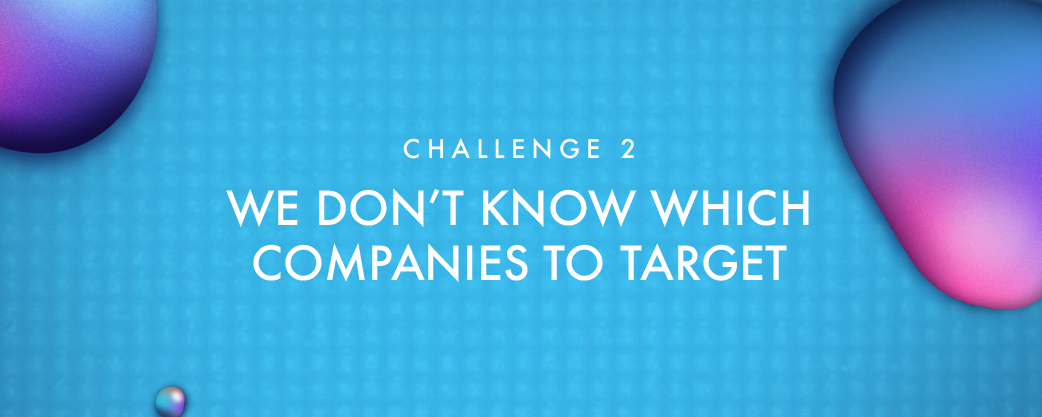As award-winning ABM experts, we’re lucky to have the opportunity to share our knowledge and experience with fellow marketers. We’ve just hosted another brilliant workshop “How to make your ABM sweat”, where we helped our attendees get their ABM strategies into shape and working hard for 2020. Plus, we were joined by our client Duncan Casemore, Applaud’s CTO, who talked through his positive experience of using an ABM strategy (courtesy of Digital Radish), which included a dissection of Applaud’s ongoing and successful campaign, the challenges and most importantly the successes.
With guests attending from a wide range of industries, from CMOs at tech brands to ABM specialists, all discussing their real-life ABM challenges and successes, there was a lot of great insight shared around the table. So, to help others in similar situations, we’ve created this round-up to help you overcome the top 3 most common ABM challenges marketers face.

This is a prevalent challenge for many professionals implementing ABM strategies due to the old-fashioned structures of sales and marketing environments. Before the age of personalisation and consumer-led markets, sales and marketing were used to being completely separated, with different KPIs and contrasting overall approaches to generating leads and results.
This sentiment was reflected by one of our attendees who claimed that from his experiences “marketing can easily become a scapegoat for the failures of sales.”
Our answer: “Understand sales and marketing have the same aligned goal”
Ultimately, both sales and marketing are working to grow the company. Both want more customers, more brand awareness and more profits. While each team takes a different approach, ultimately everyone has the same goal. Create harmony by expressing to both teams the benefits of ABM, explicitly defining what a good lead looks like and creating a shared view of personas.
To ensure successful alignment between the two teams, it is essential to promote collaboration and partnership. Both sales and marketing will have unique insights about accounts that can be fused together to create a powerful ABM strategy. So, sit down together right at the very beginning of a campaign, get both teams involved in kick-off calls to share ideas, share experiences, so that you’re working as one.

This question was a reoccurring point of discussion in our workshop. A critical reason why ABM fails is because people don’t have a clear picture of who to target from the beginning – which means you can’t create a solid ABM programme or effectively personalise any content to their needs.
Our answer: “One critical element of ABM is the use of very effective research and planning”
The cornerstone of ABM is account insight – we can’t stress this enough! At the beginning of your ABM strategy, you need to spend time identifying your customer’s persona, key objectives, key targets and where they account is in their buying journey, to build a highly tactical list before any implementation of the strategy or journey. Lack of account and customer insight can be detrimental to your whole process.
Once you’ve targeted your accounts, it is critical to make it personal by connecting with key decision-makers in the companies you’re targeting. One mistake many ABM beginners make is building strategies around accounts without any consideration of the people behind them. Once you know who your audience is and how they behave; you can begin creating a campaign that speaks to them personally and captures their attention.
Throughout the workshop, Duncan gave interesting examples of this challenge from our ABM work with Applaud. “Without Digital Radish’s extensive research”, he said, “it would have been impossible to develop the bespoke, hyper-personalised reports to the targeted accounts we picked.” And yes, he said this on his own accord, no bribery was involved!

Understandably, many of our attendees felt like the ABM process, campaign development through to execution, can seem quite daunting and overwhelming. This is often because people don’t have a clear structure or plan in place for ABM, and as ABM has been designed to be a very strategic marketing tool it’s a long-term strategy without any short-cuts.
Our answer: “ABM is a marathon, not a sprint”
The proof is in the planning. If you want a successful ABM campaign, you have to put the time in and follow a framework. Many ABM campaigns fail because there’s no clear structure or foundation built to support them. Whilst there are many factors that can affect the timescale of your campaign, you can use this framework as an outline for your ABM programme:
- Step 1: Account selection – opportunity sizing, propensity modelling and defined target account list
- Step 2: Planning and insight – account research and profiling
- Step 3: Messaging and propositions – account vision and propositions
- Step 4: Content and communication – content, digital media and marcomms
- Step 5: Campaign planning and activation – customer journeys and go-to-market plan
- Step 6: Sales enablement – centralising and creating sales resources
- Step 7: Account and programme reporting
We have more tips and tricks for implementing and executing highly-targeted campaigns here.
Want to join our next roundtable?
Roundtables are a fantastic opportunity to share ideas with fellow marketers, learn from the experts and get inspired using examples to get your ABM in top shape for 2020. We’re delighted to announce that our next ABM roundtable will be held on the 26th of March at Digital Radish’s HQ in Bloomsbury.
To reserve your place, please email: masterclasses@digitalradish.co.uk

